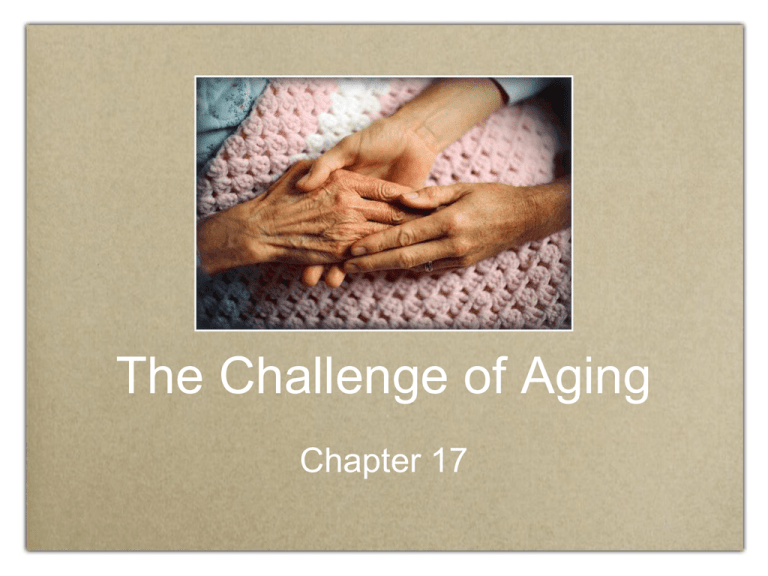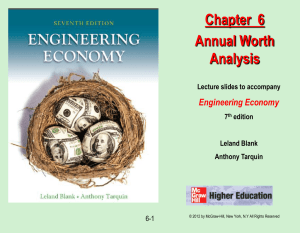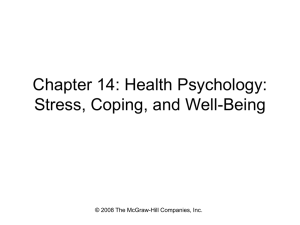
The Challenge of Aging
Chapter 17
The Challenge of
Aging
– Normal process of development that occurs
throughout life
• Generating vitality as you age
– Biological aging: the normal, progressive,
irreversible changes to one’s body that begin at
birth and continue until death
– Psychological and social aging: more abrupt
changes in circumstances and emotion
– Successful aging requires preparation
• What happens as you age?
– Characteristics associated with aging are not due to
aging at all
• Result of neglect and abuse of our bodies and minds
©2012 McGraw-Hill Higher Education. All rights reserved.
2
Life-Enhancing Measures:
Age-Proofing
• Challenge your mind
– Older adults who stay mentally active have a lower risk
of developing dementia
• Develop physical fitness
– Enhances both psychological and physical health
• Eat wisely
– Eat a varied diet full of nutrient-rich foods
– Guidelines for older adults:
•
•
•
•
Get enough vitamin B-12 and vitamin D
Limit sodium intake and get enough potassium
Consume foods rich in dietary fiber and drink plenty of water
Pay special attention to food safety
©2012 McGraw-Hill Higher Education. All rights reserved.
3
Life-Enhancing Measures:
Age-Proofing
• Maintain a healthy weight
• Control drinking and overdependence on
medications
• Don’t smoke
• Schedule screenings and physical
examinations to detect treatable diseases
• Recognize and reduce stress
©2012 McGraw-Hill Higher Education. All rights reserved.
4
Dealing With The
Changes Of Aging
• Planning for social changes
–Changing roles and relationships
• Major feature of life
–Increased leisure time
• Many people do not know how to enjoy
their free time
–The economics of retirement
• Financial planning should begin early in
life
©2012 McGraw-Hill Higher Education. All rights reserved.
5
Adapting to Physical
Changes
• Hearing loss
• Vision changes
– Age-related macular degeneration (AMD)
– Presbyopia
– Cataracts
• Arthritis
– Osteoarthritis (OA) is the most common type of
arthritis
• Menopause
– Usually occurs during a woman’s 40s or 50s
– Perimenopause
• Osteoporosis
©2012 McGraw-Hill Higher Education. All rights reserved.
6
Handling Psychological and
Mental Changes
• Dementia
– Sever and significant brain deterioration in
elderly individuals
– Affects 7% of people under the age of 80
– Two most common types of dementia
1. Alzheimer’s disease
– Changes in brain nerve cells
2. Multi-infarct dementia
– Series of small strokes or changes in the brain’s
blood supply that destroy brain tissue
©2012 McGraw-Hill Higher Education. All rights reserved.
7
Handling Psychological and
Mental Changes
• Grief
– Dealing with grief and mourning
– Aging is associated with loss
• Depression
– Unresolved grief can lead to depression, a
common problem in older adults
©2012 McGraw-Hill Higher Education. All rights reserved.
8
Aging And Life
Expectancy
• Life expectancy
– Average length of time we can expect to live
– In 2006, life expectancy for the total
population was 78.1 years
– Those who reach age 65 can expect to live
even longer, 18 years or more longer
– Women have longer life expectancy than
men
©2012 McGraw-Hill Higher Education. All rights reserved.
9
Aging and Life
Expectancy
• America’s aging minority
– People 65 and over are a large minority of
American population
• Over 37.3 million people
• About 12% of the total population in 2006
• Expected to double by 2030
– Social Security benefits
• 90% of total income for one-third
of Americans over age 65
©2012 McGraw-Hill Higher Education. All rights reserved.
10
Family and Community
Resources for Older Adults
• 66% of noninstitutionalized older
Americans live with a spouse or family
member
• 30% live alone
• Only 4% live in institutional settings
• Of those over the age of 85, about 15%
live in a nursing home
©2012 McGraw-Hill Higher Education. All rights reserved.
11
Family and Community
Resources for Older Adults
• Governmental aid and policies
– Social security
– Medicare
• Pays about 30% of the medical costs of older Americans
– Medicaid
• Health care for older adults
– Gerontologists
– Geriatricians
©2012 McGraw-Hill Higher Education. All rights reserved.
12
What is Death?
• Defining death
– Defined as cessation of the flow of vital bodily fluids
• Heart stops beating and breathing ceases
• Life-support systems
– Brain death
• Harvard medical school committee – brain death involves:
1.
2.
3.
4.
Lack of receptivity and response to external stimuli
Absence of spontaneous muscular movement and spontaneous
breathing
Absence of observable reflexes
Absence of brain activity on EEG
» Check a second time after 24 hours
» Excludes cases of hypothermia
• Clinical death
• Cellular death
©2012 McGraw-Hill Higher Education. All rights reserved.
13
Learning About Death
• A child’s understanding of death evolves
greatly from about age 5 to age 9
– Most children come to understand that death is
final, universal, and inevitable
• Mature understanding of death
– Impact on relationships
– Religious or philosophical answers
©2012 McGraw-Hill Higher Education. All rights reserved.
14
Denying Versus
Welcoming Death
• Individuals often maintain conflicting or
ambivalent attitudes toward death
• Few people wholly avoid or wholly
welcome death
©2012 McGraw-Hill Higher Education. All rights reserved.
15
Planning For Death
• Making a will
– A legal instrument expressing a person’s
intentions and wishes for the disposition of
his or her property after death
•
•
•
•
Estate
Testator
Intestate
Testamentary letter
– Document includes information about your personal
affairs (bank accounts, credit cards, location of
documents, people to notify etc.)
©2012 McGraw-Hill Higher Education. All rights reserved.
16
Considering Options for
End-of-Life Care
• Home care
• Hospital-based palliative care
– Focuses on controlling pain and relieving
suffering by caring for the physical,
psychological, spiritual, and existential
needs of the patient
• Hospice programs
– Palliative care
©2012 McGraw-Hill Higher Education. All rights reserved.
17
Deciding to Prolong Life or
Hasten Death
• Persistent vegetative state
• Withholding or withdrawing treatment
(passive euthanasia)
• Assisted suicide and active euthanasia
– Physician-assisted suicide (PAS)
• Physician provides lethal drugs or other interventions
at the patient’s request; patient administers fatal dose
– Active euthanasia
• Intentional act of killing someone who would otherwise
suffer from an©2012
incurable
and painful disease
McGraw-Hill Higher Education. All rights reserved.
18
Completing an Advance
Directive
• Any statement made by a competent
person about choices for medical treatment
should he or she become unable to make
such decisions or communicate them later
• Two forms:
1. Living will
2. Health care proxy
•
Surrogate (decision maker)
©2012 McGraw-Hill Higher Education. All rights reserved.
19
Becoming an Organ
Donor
• Each day about 77 people receive an
organ transplant while another 19
people on the waiting list die because
not enough organs are available
– Nearly 110,000 Americans were waiting for
organ transplants as of July 2010
• Uniform Donor Card
• Driver’s license designation
©2012 McGraw-Hill Higher Education. All rights reserved.
20
Planning a Funeral or
Memorial Service
• Disposition of the body
– Burial
– Cremation
– Embalming
– Green burial
• Arranging a service
©2012 McGraw-Hill Higher Education. All rights reserved.
21
Coping With Dying
• The tasks of coping
– Elizabeth Kubler-Ross and the five stages of dying
1. Denial
2. Anger
3. Bargaining
4. Depression
5. Acceptance
– Charles Corr and the four primary dimensions in
coping with dying:
1. Physical
2. Psychological
3. Social
4. Spiritual
• Supporting a dying person
©2012 McGraw-Hill Higher Education. All rights reserved.
22
Coping With Loss
• Experiencing grief
– Bereavement
– Mourning
• Tasks of mourning
1.Accepting reality
2.Working through the pain
3.Adjusting to a changed environment
4.Emotionally relocating the deceased and moving on
with life
• The course of grief
– Complicated grief
• Supporting a grieving person
• Coming to terms with death
©2012 McGraw-Hill Higher Education. All rights reserved.
23
Coping With Loss
The Challenge of Aging
Chapter 17









